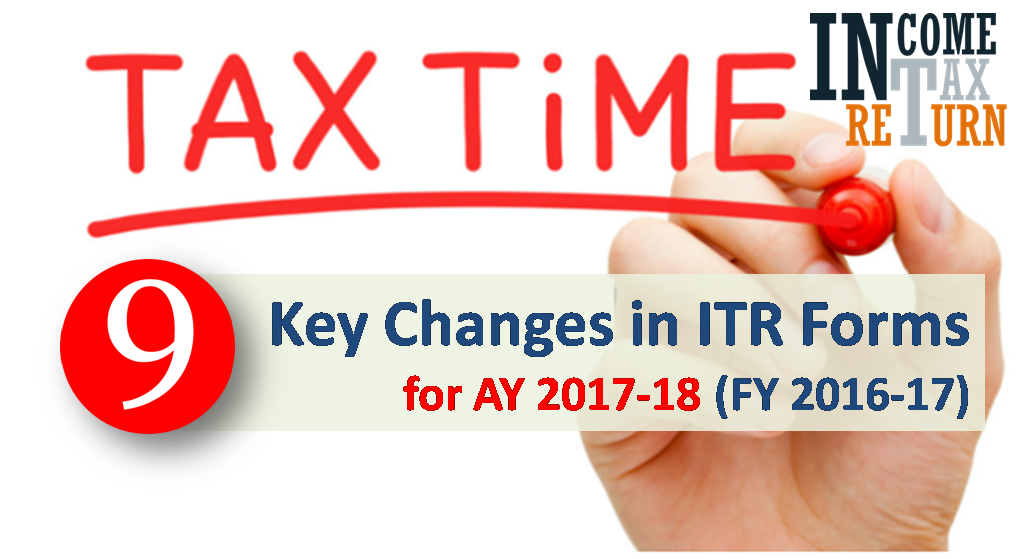Some Major changes in ITR forms introduced in the latest Budget seems to have made the process a bit less complicated for the individual tax payers. Yes it does make a difference since the more complex is the procedure, more is it likely that details would be forged or incorrect. Our honourable Finance Minister, Mr. Arun Jaitley, has been making huge strides to bring about improvement in the overall economic structure of the country whether it is easing out the processes or making them more integrative or for that matter more detailed to ensure that nothing is hidden from the Indian government.

CBDT notified about the updated ITR forms that will be applicable for filing returns for the income earned in the period April 1, 2016 to March 31, 2017.- Let’s see Major Changes in ITR forms for Ay 2017-18
One of the major changes is a simplified yet detailed one pager form i.e. ITR 1 applicable for individuals having income from pension, salary, one house property and income from other sources like interest etc. This form would cover almost 90% of the individual category tax payers like salaried people, housewives, pensioners and so on.
Major changes in ITR Forms -AY1718
Number of ITR forms reduced from 9 to 7 –
The number of forms have been reduced to 7 as against the previous 9 forms
- Form ITR-2 now stands to be a single consolidated version of Form ITR-2A, Form ITR-2 and Form ITR-3
- Form ITR-4 is now Form ITR-3
- Previous Form ITR-4S (Sugam) is now numbered as Form ITR-4 (Sugam)
- The new Form ITR-1 Sahaj is a one pager form that demands disclosure of crisp information that would cover individuals falling under:
- Income from salary/pension
- Income from one house property
- Income from other sources like interest etc.
Note: the upper limit for the income for the above categories is limited to a total of Rs. 50,00,000/- only
Moroever, the below do not fall under the purview of the above form criteria:
- Dividend income exceeding Rs. 10 lakhs covered U/s 115BBDA
- Unexplained cash credit or investment taxable at 60% U/s 115BBE
- Agriculture income exceeding Rs. 5000/-
-
Overview of changes in ITR form for Ay1718
- The 18 sub headings under “Deduction under Chapter VIA” reduced to 5 that are frequently used i.e. sections 80C, 80D, 80G, 80TTA and any other (to include any deduction that falls out of these 4 sections purview)
- No need to provide details like Name, PAN and address of the done for donations made u/s 80G
- TDS and TCS schedules have been merged
- With Rs. 50 lakhs as the threshold to report specified assets and liabilities, the said section has been removed from Form ITR-1 for individuals with an income less than Rs. 50 lakhs
- Under schedule “exempt income,” the specific disclosure needs to be done for the below income:
- Dividend income earned u/s 10(34) of the Act
- Long term capital gain earned u/s 10(38) of the Act
- Agricultural income not exceeding Rs. 5000/- and
- Others (specify)
- A new column for “disclosure of cash deposited between November 9, 2016 and December 30, 2016” has been inserted in all the new ITR forms wherein details of cash deposited by tax payers in their bank accounts in the aforementioned period must be reported
- Quoting of Aadhaar Number – It has been made mandatory to quote your Aadhaar number w.e.f July 01, 2017 in Form ITR 1,2, 3, 4 however in case the individual is yet to obtain Aadhaar number then the Enrolment ID of Aadhaar application needs to filled in the ITR. Also every tax payer’s PAN needs to be linked with Aadhaar number; failing which the tax payer’s PAN will stand to be invalid.
- Detailed declaration of value of assets/liabilities by individuals as well as HUF with income exceeding Rs. 50 lakhs – Since last year, individuals as well as HUF are required to disclose the value of the below mentioned additional details:
- Immovable assets – The tax payer needs to provide address of each immovable property held by him/her
- Movable assets:
- Financial assets at cost (Bank including all deposits, shares and securities, insurance policies, loans and advances given)
- Details of archaeological collections, drawings, paintings, sculptures or any other work of art
- Members/partners to disclose name, address, PAN of the firm or AOP and the assessee’s investment
Most of the changes in ITR forms hold good for those tax payers whose income does not exceed Rs. 50 lakhs and those whose income exceeds this limit have to disclose further details.